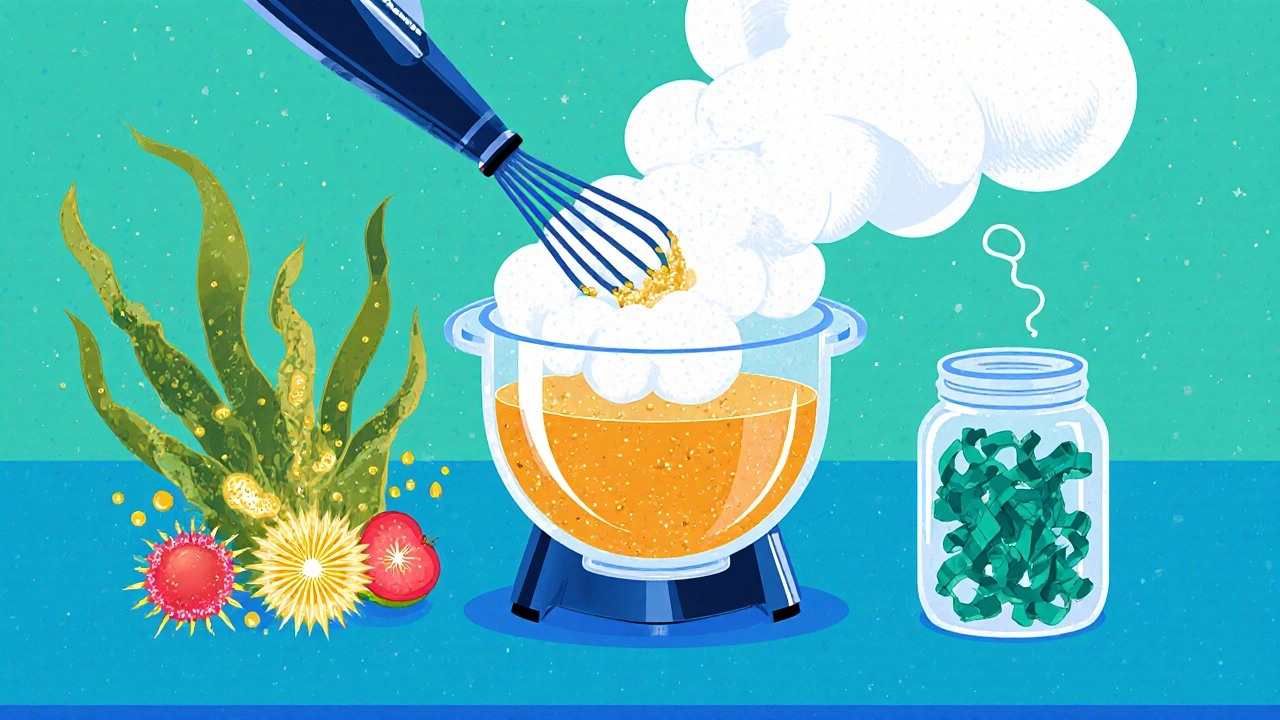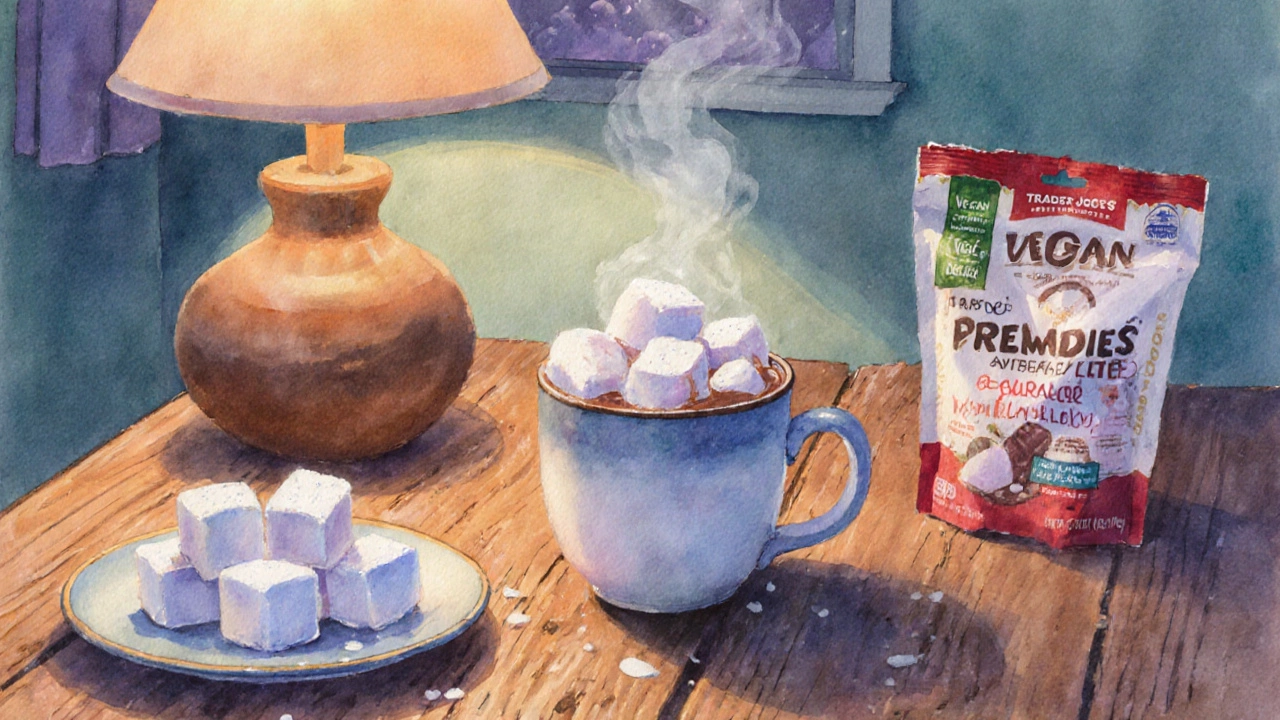Vegan Marshmallow Ingredient Checker
Check if your marshmallows are truly vegan by analyzing the ingredient list. Enter ingredients separated by commas or paste the full ingredient list.
Results will appear here after checking.
Key Takeaways
- Traditional marshmallows rely on gelatin, which is animal‑derived.
- Plant‑based gelling agents like agar‑agar, carrageenan, and pectin let you make truly vegan marshmallows.
- Check the ingredient list: look for gelatin, animal‑derived flavorings, or hidden dairy.
- Several stocked brands now offer certified vegan marshmallows - Dandies and Trader Joe’s lead the pack.
- Homemade vegan marshmallows are easy and only need a few pantry staples.
When you toss a handful of vegan marshmallows into hot cocoa, the first thing you wonder is - are they really plant‑based, or is there hidden animal glue in there? The answer isn’t a simple yes or no because it depends on the brand, the recipe, and sometimes even the country where they’re made. This guide breaks down exactly what makes a marshmallow vegan, how to read labels, which store‑bought options you can trust, and a fool‑proof recipe for making your own.
Marshmallow is a soft, airy confection created by whipping sugar, water, and a gelling agent into a fluffy foam. Historically, the gelling agent has been gelatin, extracted from animal collagen, which is why most mass‑produced marshmallows are off‑limits for vegans.
What Gives Marshmallows Their Bounce?
The magic happens when a liquid sugar syrup meets a protein or polysaccharide that can set into a gel. In classic recipes, that protein is gelatin. Gelatin forms a flexible network that traps air bubbles, giving marshmallows their signature chew.
Gelatin is derived from pork or beef hides, bone, or connective tissue. Because it’s animal‑based, any marshmallow that lists gelatin is automatically non‑vegan.
Vegans replace gelatin with plant‑derived gelling agents. The most common substitutes are:
- Agar‑agar - a seaweed extract that sets firm and holds heat well.
- Carrageenan - another seaweed‑derived thickener, often used in dairy alternatives.
- Pectin - a fruit‑based polysaccharide that gives a softer set.
Each works a bit differently. Agar‑agar creates a bite that's slightly firmer than gelatin, making it perfect for marshmallows that need to keep their shape in hot drinks. Carrageenan can be a little gummy if over‑used, while pectin yields a melt‑in‑your‑mouth texture but can be tricky to get right without acid or sugar balance.
Are Store‑Bought Marshmallows Vegan?
Most supermarket brands still use gelatin, but the market is shifting. In 2025, a handful of brands have gone completely vegan and label their packaging clearly. When you’re scanning a shelf, keep an eye out for these keywords:
- “Plant‑based,” “Vegan,” or a certified vegan logo.
- Absence of “gelatin,” “animal collagen,” “bone broth,” or “gelatinous” in the ingredient list.
- Notes about “no animal‑derived flavors” - some marshmallows use butter‑derived vanillin.
If you’re uncertain, the safest move is to check the manufacturer’s website or contact their customer service. Some large brands list a “Allergen Information” table that flags gelatin separately.

How to Spot a Vegan Marshmallow
Here’s a quick checklist you can keep in your kitchen drawer:
- Read the ingredients line‑by‑line. If you see “gelatin” anywhere, it’s out.
- Look for alternative gelling agents - “agar‑agar,” “carrageenan,” or “pectin” are good signs.
- Check for dairy‑free claims. Some marshmallows contain whey powder for flavor.
- Search for a vegan certification logo (Vegan Society, Plant‑Based Foods Association).
- When in doubt, visit the brand’s FAQ page - many now have a “Vegan” section.
Making Your Own Vegan Marshmallows
Homemade versions let you control every ingredient. Below is a tested recipe that yields about 30 bite‑size marshmallows.
Ingredients
- 1 cup water (divided)
- 2 cups granulated Sugar
- ½ cup light corn syrup
- ¼ tsp salt
- 2 tsp agar‑agar powder (or 1 tsp carrageenan)
- 1 tsp vanilla extract (ensure it’s plant‑based)
- Powdered sugar for dusting
Equipment
- Heavy‑bottom saucepan
- Stand mixer with whisk attachment
- Silicone spatula
- 9 × 13 in baking pan
Steps
- Combine ½ cup water, sugar, corn syrup, and salt in the saucepan. Heat over medium‑high until the mixture reaches 240 °F (soft‑ball stage). Use a candy thermometer.
- Meanwhile, whisk agar‑agar with the remaining ½ cup water in a small bowl. Bring to a boil for 2 minutes to fully dissolve.
- When the sugar syrup hits 240 °F, remove from heat and gradually pour the hot agar‑agar solution into the mixer bowl while the mixer runs on low.
- Increase the mixer speed to high and whip for 8-10 minutes, until the mixture triples in volume and looks glossy.
- Add vanilla extract and give a quick 30‑second mix.
- Spread the foam into the prepared pan, smoothing the top with a spatula. Let it set at room temperature for at least 4 hours or overnight.
- Turn the set marshmallow slab onto a cutting board, dust with powdered sugar, and cut into squares. Toss the pieces in more powdered sugar to prevent sticking.
Store the finished marshmallows in an airtight container. They stay fresh for up to a week, and the texture actually improves after a day.

Top Vegan Marshmallow Brands in 2025
| Brand | Gelling Agent | Flavors | Allergen Info | Price (CAD) |
|---|---|---|---|---|
| Dandies | Agar‑agar | Original, Strawberry, Peanut Butter | Gluten‑free, soy‑free | $5.99 (200 g) |
| Trader Joe’s Vegan Marshmallows | Pectin | Original | Non‑GMO, soy‑free | $4.49 (210 g) |
| Vegan52 | Agar‑agar | Original, Mango | Gluten‑free, soy‑free, nut‑free | $6.79 (250 g) |
| Happy Marsh | Carrageenan | Original, Coffee | Contains soy | $5.25 (220 g) |
All four brands have passed a third‑party vegan certification, but note the allergen column if you have nut or soy sensitivities. Happy Marsh uses carrageenan, which some people avoid due to digestive concerns, so those individuals might prefer Dandies or Vegan52.
Frequently Asked Questions
Can I use gelatin‑free marshmallows in a vegan bakesale?
Yes - just double‑check the label for any animal‑derived additives like whey or butter flavor. If the package carries a vegan logo, you’re safe.
Is agar‑agar the best substitute for gelatin?
Agar‑agar is the most reliable because it sets at room temperature and holds up in hot drinks. It does give a slightly firmer bite, which many people actually prefer in marshmallows.
Do vegan marshmallows melt the same way as regular ones?
They melt, but the texture can be a bit less stretchy. Agar‑agar based marshmallows become gooey, while pectin‑based ones stay softer and melt more slowly.
Are there any health concerns with carrageenan?
Some studies link degraded carrageenan to inflammation, but the food‑grade version used in confectionery is generally recognized as safe. If you have a sensitive gut, stick with agar‑agar or pectin.
Can I store homemade vegan marshmallows in the fridge?
Yes, but keep them in an airtight container to prevent them from drying out. They stay soft for up to two weeks in the fridge.
Whether you’re buying a bag from the grocery aisle or whipping up your own batch, knowing the ingredients is the key to keeping your treats truly vegan. Armed with the checklist, brand guide, and recipe, you can enjoy fluffy sweetness without compromising your values.





